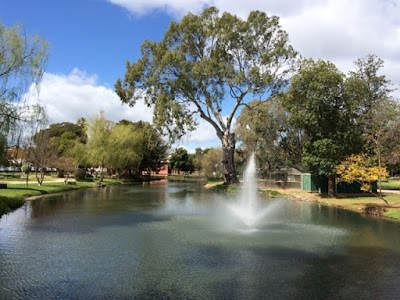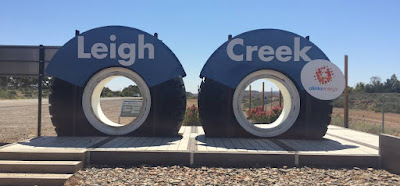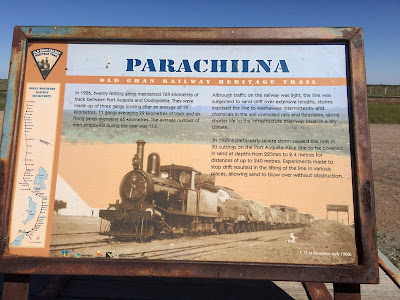Menindee Lakes, Kinchega National Park and the road home........
Leaving early the next morning it wasn't long before we had found our way to the Menindee Lakes Caravan Park. Still in outback NSW this park would have once been full to the brim as it sits just above Menindee Lake.
Sadly now the lake is completely dry, a result of years of drought and water management (?) supplying water to Broken Hill, NSW and SA under the Murray-Darling Basin Agreement.
Once we were settled and the washing on the line we jumped in the car to explore a little further. We drove down to see Copi Hollow, a natural lake where there is still water, and found another caravan park, a boat club and some happy water birds.
From here we drove around to have a look at Main Weir, one of the many water management controls throughout the lakes system. We found some more birds, a little water and a great campsite.
Back in Menindee we had a look at the tiny town which was proclaimed 'the first town on the Darling River'. It also has great historical significance as 5 explorers passed through here in the 1800's. These were Major Thomas Mitchell in 1835, Charles Sturt in 1844, John McKinlay in 1855 then Burke and Wills in 1860. As we returned home that afternoon we stopped to see the grave of Dost Mahomet, Burke and Wills camel driver. He had made it to the Coopers Creek campsite with them but was disabled by a rogue camel. Once recovered he spent the rest of his life here in Menindee.
The next morning we set out to explore The Kinchega National Park. The park follows the Darling River and there are many lovely campsites along here. We have found many places we would love to come back to, so one day there may be more stories from this beautiful part of the country.
After lunch we stopped and had a look at the Historic Kinchega Woolshed which has been maintained as a heritage site. You can walk through this wonderful space and imagine just how things would have been in many shearing sheds across the land.
Another stop saw us stop at the ruins of the Kinchega Homestead and as we followed the storyboards down to the river we came across an Emu who had just had two little chicks hatch. We watched in awe as Dad checked the babies and settled back down on the third and final egg.
We did wait for quite some time but with no more signs of hatching we finally said goodbye and left the little family in peace. Such an amazing sight and one we may never see again.
The next morning we were on our way again, this time on 209 km of red dirt road as we drove across to Ivanhoe. No one had been able to tell us the condition of the road but we found a really smooth, well maintained track and we arrived at our destination far quicker than we had expected. We found a spot in the caravan park behind the service station and had a wander along the Main Street.
It was very quiet as it was Sunday afternoon and we met a lovely couple who had just moved up from Albany in WA to take over the pub. We chatted to them for a while on the veranda before heading back across the road for a quiet afternoon in. We did return to the pub for dinner that night. The lasagna was pretty good!
Back on the road the next day we made our way towards Hay where we stopped for a coffee at Booligal. This tiny towns claim to fame is being mentioned in one of Banjo Paterson's poems, Hay and Hell and Booligal. I had never heard of it until I checked Google and here found out that the little town was not too impressed as being described the way they were!
Our next stop was at One Tree, a pit stop on the way across the Hay Plains. One Tree Inn is a public house built on this site in 1862 when the locality developed as a coach changing stage and watering place between the Murrumbidgee and Lachlan rivers for Cobb and Co. One Tree village was surveyed and proclaimed in 1882, named after the lone gum tree standing which stood in a field nearby. The tree has since been destroyed by storms in 1900 and the original building was burnt down in 1903 and rebuilt in the same style later. Now it seems to be empty, fenced off and a nesting site for the many Welcome Swallows we saw there.
Driving across the Hay Plains was another incredible journey with land so flat in every direction. It is said to be one of the flattest places on earth with only 17m (56 feet) of difference in elevation between the highest and lowest point in the Hay Shire.
As we approached Hay we found water in the creeks and rivers for the first time in many many weeks and soon after found our campsite at Sandy Beach, a fabulous free camp beside the beautiful Murrumbidgee River. On arrival there were many vans there and many more came in during the afternoon but at no time was this lovely place ever full. The council provide this area for travellers which gives us somewhere safe to stay and explore their lovely town.
We did that during the afternoon when we walked into town, enjoyed reading about the history of Hay on a heritage trail, had a coffee at a local cafe and a walk back along the river. With too much to see in just an overnight stop we will have to visit again and really do this lovely place justice.
Just one stop on our way out of town the next morning at the Old Railway Station which we found is also a museum. Housed in old railway carriages The Dunera Museum and The Hay Internment and POW Camps Interpretive Centre housed there tells the stories of over 6,600 German, Italian, Japenese and Australian civilian Internees and Italian and Japanese POW's imprisoned there between 1940 and 1946 in three camps 6,7,8 of 1,000 men each. Unfortunately this was not open when we stopped so we will try again next time.
This morning we had been going to cross the border into Victoria and spend one more night on the road but with a cold change in the weather and home so close we decided that we would drive straight there. We stopped in Deniliquin for a quick look, crossed the border at Euchua, ate our lunch in the van at a roadside stop and arrived home safely at about 3.30 that afternoon.
At this point it seemed very strange to think that our big adventure was over. We had just spent the most amazing four months on the road. We have caught up with friends and made some new ones along the way. We have seen many places that until now have only ever been names on maps and perhaps dreams of 'one day' and we have loved every moment of this great experience, yes even the tyres! I think Bill tells it best with his Facebook post once we got home, I hope you can read it and by the way I dispute the argument count!
Once the van was parked in the driveway (first try, I might add) we made our way inside to reacquaint ourselves with our home once more. It seemed very strange to have so much room to move around in and for days we kept forgetting which cupboard had what in it. The weather was still chilly and Bill would have happily gone north again for the first few days but soon the sun shone and the temperature climbed a little so all was well.
So for now I'll finish our story here as we spend a couple of weeks at home and work out what comes next.
Until next time..........









































